NOTE: Though this is PART II of Maury and my research into the “J” logo, it mostly predates that article. This should be considered a working draft, as I’m sure we’ll learn new things and make editorial improvements to it. If you spot something in error, email me or comment below.
 When Maury Hurt and I were researching the short-lived “J” logo, we found ourselves looking back into Willys-Overland advertising during WWII. That, in turn, led to the development of the large Saturday Evening Post and Collier’s Magazine images showing all the ads Willys-Overland took out during the war so we could more easily compare how Willys-Overland marketing evolved. That work proved quite useful, showing us visually how the pre-war Willys-Overland company became, for all practical purposes, the post-war Willys ‘Jeep’ company.
When Maury Hurt and I were researching the short-lived “J” logo, we found ourselves looking back into Willys-Overland advertising during WWII. That, in turn, led to the development of the large Saturday Evening Post and Collier’s Magazine images showing all the ads Willys-Overland took out during the war so we could more easily compare how Willys-Overland marketing evolved. That work proved quite useful, showing us visually how the pre-war Willys-Overland company became, for all practical purposes, the post-war Willys ‘Jeep’ company.
FRED COLDWELL’S “SELLING THE ALL-AMERICAN WONDER”:
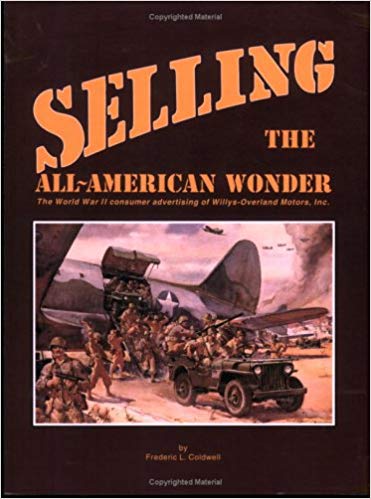 Anyone who has read Fred Coldwell’s excellent book “Selling The All-American Wonder” knows that studying the WWII ads that Willys-Overland published during the war isn’t ground breaking. However, Fred focused his book on the legal challenges Willys-Overland faced when trying to secure the rights to trademark the name JEEP so the company could sell jeeps to the post-war public.
Anyone who has read Fred Coldwell’s excellent book “Selling The All-American Wonder” knows that studying the WWII ads that Willys-Overland published during the war isn’t ground breaking. However, Fred focused his book on the legal challenges Willys-Overland faced when trying to secure the rights to trademark the name JEEP so the company could sell jeeps to the post-war public.
As Fred explained in his book, Willys-Overland faced a huge hurdle to transform the generic word jeep into a Trademark. Prior to the introduction of the Bantam BRC in September of 1940, the term JEEP had been applied to a magical cartoon character in Popeye, to Army grunts, to a type of train, to another category of military vehicle(Dodge Command Car), the MM Tractor, and to a category of planes, as this 1939 Boy’s Life Magazine highlighted (the term would continue to be used for that category of planes in magazine articles and ads throughout WWII.)
By mid-November of 1940, which was after the Bantam BRC and Willys Quad were introduced, both vehicles were already being referred to as jeeps. However, this was prior to the introduction of the Ford Pygmy in late November (which wasn’t being called a FORD GP at that point, nor even by early 1941).
Because of these complexities, Willys-Overland pushed to advertise in major publications during WWII to reinforce to the public the idea that the Jeep was a Willys product. To that end, Fred’s book highlights the type of WWII advertisements used to achieve that trademark goal (and Fred’s full-size reproductions of the ads are excellent and a much cheaper way of finding the ads then by purchasing magazines). Willys-Overland eventually secured the trademark JEEP in 1950.
HOW OUR APPROACH DIFFERED FROM FRED’S WORK:
Our review of the material differed in that we were trying to document how Willys-Overland arrived at the final the logo and text choices the company made.
Let’s not forget the state of the company prior to the war. In 1937, Willys-Overland produced 63,000 vehicles, but a recession wiped out sales the following year and Willys sales declined to a terrible 17,000 cars and trucks. Things were so bad that by 1940 earnings were a negative -$800,000 (read more here). In other words, Willys-Overland, as a car and truck company, wasn’t succeeding. And, like Bantam, Willys-Overland hoped a military contract would rescue the company.
Though Bantam lost out, Willys-Overland’s securing of the military contract for ‘scout cars’ in 1941 led to a significant financial turn-around. That year earnings bounced back, totaling $800,000 in the black. Things were looking up for the company.
With the new military contract and cash, coupled with an exciting new vehicle (the jeep), Willys started advertising more aggressively. Fred Coldwell notes that the earliest major advertisement, published in the December 13, 1941, issue of the Saturday Evening Post was titled The Jeep in Civvies. This ad promoted both the new army jeep and its connection to the 1942 Americar, Willys-Overland’s new creation led by former Chrysler Executive Joe Frazer.
Subsequent magazine ads from Willys-Overland in early 1942 also harnessed the Jeep in Civvies slogan, but added to the advertisements were illustrations of a Willys Americar and a Willys slat grille jeep; in-between the two illustrations was the WILLYS logo in bold and an image of the Go-Devil engine. Underneath the large WILLYS logo was the sub-line: MOTOR CARS [Engine Image] TRUCKS AND JEEPS.
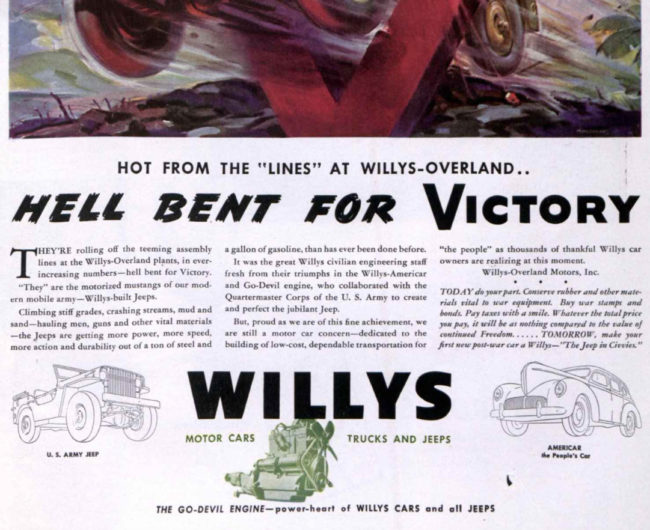
The ad, HELL BENT FOR VICTORY, was published in the June 27, 1942, issue of the Saturday Evening Post. The WILLYS brand is prominent. JEEP is mentioned, but it’s after MOTOR CARS, an engine, TRUCKS.
To me this was a crucial step for Willys-Overland to take, as it meant the company recognized that the jeep was its own thing, not a car and not a truck, but some third type of vehicle. Maybe the company should have called it a Military Utility Vehicle (MUV?), or something else generic, then branded their model of MUV “a jeep” to help their future trademark fight (and this ladies and gentleman is why I didn’t have a career in marketing .. a MUV? That’s the best I can do?).
More importantly by June 27, 1942, Willys-Overland still underscored how the company identified itself, stating in the HELL BENT FOR VICTORY ad from above:
As proud as we are of this fine achievement (building the jeep), we are still a motor car concern….
WORLD OF JEEPS:
By the time the summer of 1942 came and went, around 100,000 MBs and GPWs had already been built. With war raging everywhere, soldiers and jeeps were landing around the world. Willys-Overland recognized the global nature of their iconic vehicle, so on September 19, 1942, the company introduced a new slogan: THE SUN NEVER SETS ON THE WILLYS JEEP.

This ad, THE SUN NEVER SETS ON THE WILLYS JEEP, was published in the September 19, 1942, issue of the Saturday Evening Post, page 109.
The subsequent ad in October 1942 included a small badge with the verbiage slightly altered: THE SUN NEVER SETS ON THE WILLYS JEEP. The badge would be included on most ads through May of 1944, though there would be additional verbiage changes.
In January of 1943, the phrase was altered into THE SUN NEVER SETS ON THE FIGHTING JEEP.

This ad, AVENGING JEEPS BLAST JAPS FROM CHINESE VILLAGE, was published in the February 06, 1943, issue of the Saturday Evening Post, page 85.
The “Fighting Jeep” phrase lasted through May of 1943. Then, the was left off of a few ads, before returning on July of 1943 with the replacement of Fighting with Mighty: THE SUN NEVER SETS ON THE MIGHTY JEEP.

This ad, HEROIC OFFICERS DARE DEATH FOR MEN, was published in the July 17, 1943, issue of the Saturday Evening Post, page 97.
JEEPS BECOME THE PRIORITY:
Despite the rapid changes happening at Willys-Overland, throughout 1942 and into the summer of 1943, Willys-Overland never forgot its roots as a car company, as cars and references to post war cars snuck into ads, usually at the bottom.
But, change was on the horizon.
First, a May 22, 1943, ad from Willys titled WHAT IS A JEEP? appeared in Collier’s magazine.
The fact that Willys-OVERLAND felt the need to explain what this new type of vehicle did, both in practical terms (MECHANCIAL ARMY MULE) and more romantic, passionate terms (a FLAMING BAYONET OF RETRIBUTION) to the American public set the stage for why the vehicle was important. But, even in that ad, the company left unsaid what the jeep might mean for post-war civilians.
Second, several months later. in September 9, 1943, Willys posted an ad in the Saturday Evening Post highlighting a big shift in emphasis and corporate direction. The bottom of the ads changed dramatically. No longer was the outline of a car and jeep shown, separated by the WILLYS logo and an engine image. Instead, the car was gone (for the remainder of the ad campaign). Moreover, the order of the vehicle categories had switched. No longer was it MOTOR CARS [Engine Image] TRUCKS AND JEEPS … Now it was JEEPS, MOTOR CARS AND TRUCKS [Engine image].
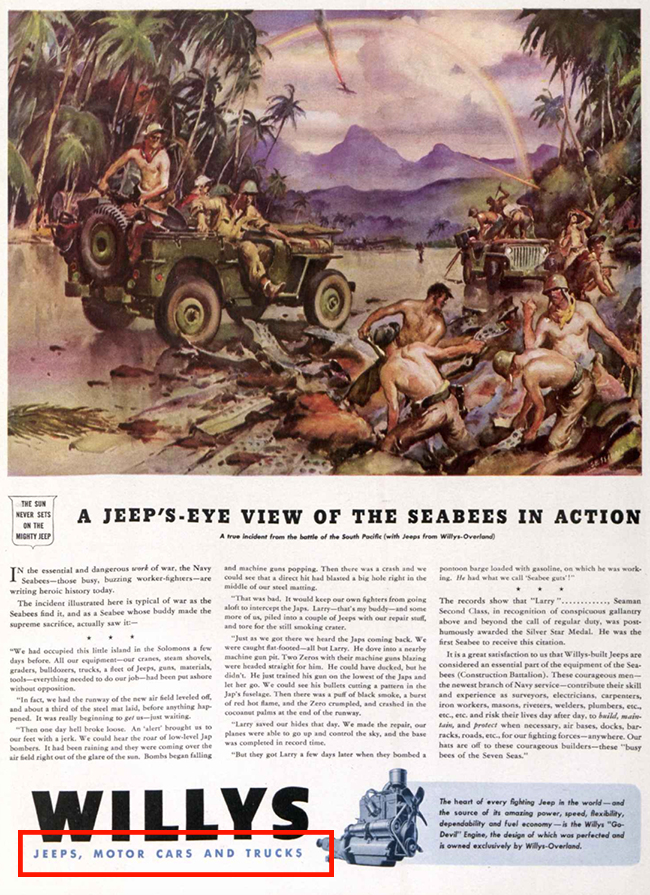
This ad, A JEEP’S-EYE VIEW OF THE SEABEES IN ACTION, was published in the September 18, 1943, issue of the Saturday Evening Post, page 117.
It seemed that the jeep’s importance now over took cars and trucks from the perspective of Willys-Overland’s executive team. Unfortunately, the problem the team faced was that they had a nation-wide network of dealers who sold cars and trucks. How could management best position the jeep for these dealers, without upsetting the dealership network’s traditional sales network?
Dealers must have wondered how much their customer base would use a jeep and how that might affect their sales, which had been pretty lean during the war years as it was (with only leftover inventory and used cars for sale).
Whatever complaints the dealers may have had, Willys-Overland doubled down on the Jeep marketing, at the expensive of post-war motor car advertising. For example, by January of 1944, Willys-Overland abandoned the bold WILLYS temporarily.

This ad, A MAGNIFICENT FOOL, was published in the January 09, 1944, issue of the Saturday Evening Post, page 97. Note that there is no more WILLYS branding. Instead, there’s a nod to the corporate brand, WiILLYS-OVERLAND MOTORS, INC., in the right lower corner.
In February of 1944, the company changed things up again. This time Willys-Overland put JEEPS in bold and in a new font.

This ad, JEEPS, was publishing in the February 05, 1944, issue of the Saturday Evening Post, page 97. Note the choice of font and font-color, along with the terms JEEP MOTOR CARS and JEEP SCOUT CARS.
In March of 1944, once again JEEPS was in bold, but this time in the color black.

This ad, JEEP PINCH-HITS FOR 21/2-TON TOW TRUCK, was publishing in the March 04, 1944, issue of the Saturday Evening Post, page 109. The font-color is changed to black and, once again, the ad includes a revference to JEEP MOTOR CARS and JEEP SCOUT CARS.
By April, management returned with a WILLYS in bold, serif font, but equally bold, large and serif was the new singular JEEP. In addition, set between WILLYS and JEEP was a new marketing slogan which effectively read, WILLYS Builds the Mighty JEEP. Why did the WILLYS branding reappear? My guess is that Willys-Overland re-introduced the WILLYS branding as a hedge in case the company lost the rights to the JEEP trademark.

This ad, THE POWER CENTER, was published in the April 01, 1944, issue of the Saturday Evening Post, page 109. Willys-Overland changed the branding to WILLYS Builds the Mighty JEEP.
Perhaps not coincidently, due to Willys-Overland’s attempt to Trademark the term JEEP in 1943 and Ford’s lawsuit in response, by April of 1944 the Federal Trade Commission was holding hearings on whether Willys could claim rights to the JEEP name and whether it had officially been the inventor of the jeep. More hearings were held in August of 1944, as reported in the Toledo Blade:
It was during the FTC hearings that two Willys-Overland employees testified that the Willys Quad and Bantam BRC prototypes had been called jeeps by folks at the Holabird testing grounds by mid November of 1940 (which was prior to the Ford Pygmy’s arrival, which also undercuts any argument that the jeep was derived from the Ford GP .. in fact, I have theorized that Ford named its jeeps GPs to undercut Willys-Overland’s claim to the term jeep, but I have real proof of that.)
It’s likely that because of the initial April 1944 FTC investigation Willys-Overland made a small, but lasting change to the jeep logo in a July 22, 1944, ad in the Saturday Evening Post. Instead of WILLYS Builds the Mighty JEEP, it became WILLYS Builds the Mighty ‘JEEP’, with the addition of single quotes around the word jeep. And, as you can also see in the ad below, sometimes jeep was surrounded by double quotes and sometimes by single quotes. Why? I suspect Willys-Overland felt they could defend the use of ‘JEEP’ with single quotes by describing it’s presence as a descriptive use of jargon, a defensible position based on the interpretation of single quotes provided by some editors.

This ad, “JEEPS” . . . DESTINATION NETTUNO!, was published in the July 22, 1944, issue of the Saturday Evening Post, page 93. This ad is the first to have the branding with single quotes ‘JEEP’.
Now, how single quotes legally transcend the FTC’s concerns isn’t clear to me, but I imagine the argument would be that Willys-Overland is only quoting what other people, including their own employees, were calling the Willys MB; further, Willys-Overland may have also argued the company was only using single quotes on the largest logo in ads for purely stylistic reasons, but still using quotes within ad text to be accurate.
Whatever the reasoning at the time, it appears that it was good enough, as ‘JEEP’ with single quotes would become the advertising brand identifier into the 1960s.
One month after the company added single quotes, for some reason Willys-Overland changed both WILLYS and JEEP to serif fonts. Either management or marketing or both couldn’t make up their minds about what the JEEP font should look like.

The ad, WILL THE “JEEP” SPEED UP FARMING?, was published in the August 19, 1944, issue of the Saturday Evening Post, page 101. Note that the font for both WILLYS and JEEP was changed once again.
WILLYS JEEP LINKS:
In mid 1944, Willys-Overland introduced the LINKED TOGETHER, IN THE MINDS OF MILLIONS ad, meant to show that Willys means ‘Jeep’ in a figurative way.

The ad, LINKED TOGETHER, IN THE MINDS OF MILLIONS, was published in the October 14, 1944, issue of the Saturday Evening Post, page 113. This appears to have introduced the “linked” advertising campaign.
The 1944 Annual Report, which would have been published in late 1944, as Willys-Overland’s financial year-end was September, also featured the linked together theme.
Further, A JEEP PLANNING brochure published by Willys-Overland to introduce the coming post war jeep featured the linked image on some pages as well.

From the undated JEEP PLANNING brochure. Given the branding, I’d guess this was produced in late 1944. Note the “link” logo at the bottom left of both pages. To view the entire document, go here.
However, the “link” imagery only seems to have lasted a few months and was abandoned as quickly as it was adopted. Because, in November of 1944, Willys-Overland produced an ad without the link.

This ad, “JEEP” INVADES MIDWEST FARM, was published in the November 11, 1944, issue of the Saturday Evening Post, page 107.
So, by the end of 1944, Any reference to cars or trucks was gone. The attempt to push aside the WILLYS branding failed, most likely do to the FTC investigation and Ford lawsuit. Yet, despite those hiccups, the advertising (and therefore the company it seems) had still transformed the perception from a company of WILLYS cars and trucks into the Willys Jeep company (and as we all know, early jeeps are still called a willys-jeeps by many folks).
THE CIVILIAN JEEP:
Finally, in July of 1945, Willys-Overland introduced the post-war CJ-2A to the world. However, the magazine ads were a little behind. It wasn’t until November 10, 1945, that the two-page spread introducing the post-war jeep appeared in the Saturday Evening Post.


This two-page spread, Willys . . . PRESENTS TO THE WORLD THE UNIVERSAL ‘JEEP’ . . ., was published in the Saturday Evening Post, pages 71 and 72.
As mentioned in Monday’s post, that two-page spread was accompanied by the Willys/Cars•Trucks/Jeep badge, meant, in Maury’s and my opinion, to help consumers relate jeeps to Willys-Overland Car and Truck dealers and to help Willys-Overland dealers of cars and trucks make the transition from Willys-Overland, a the car and truck dealer, to Willys-Overland, a Jeep dealer.
As you can see below, Willys-Overland didn’t just use the badge as transition signage. Below is another example of dealer signage that hoped to cross the dealer divide between the pre-war products and post war jeeps.
WILLYS DISAPPEARS:
As noted in this post from last week, the Willys/Cars•Trucks/Jeep badge disappeared from ads in February of 1946. This was about the same time that Willys began its “GET A JEEP” campaign in earnest, a nod to the phrase “GET A HORSE”, that was used to make fun of the early automobile makers.
Here’s a 1946 Ad that has both the “J” logo and the “Get a Jeep” phrase on it, only the latter phrase is in script, which I don’t think I’ve seen elsewhere.
Finally, by March 1946, the large WILLYS branding disappeared all-together in relation to the CJ-2A, though it would continue to appear in small print at times. Instead, it was ‘Jeep’ that took center-stage in most ads. Meanwhile, Willys-Overland Motors started appearing in small print at the bottom right of most large magazine ads.
The transformation was complete. The Willys-Overland company had transformed into the willys ‘JEEP’ company.



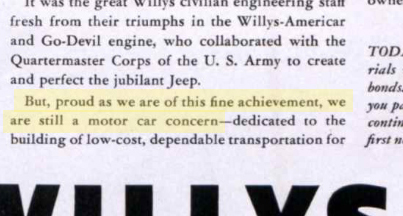
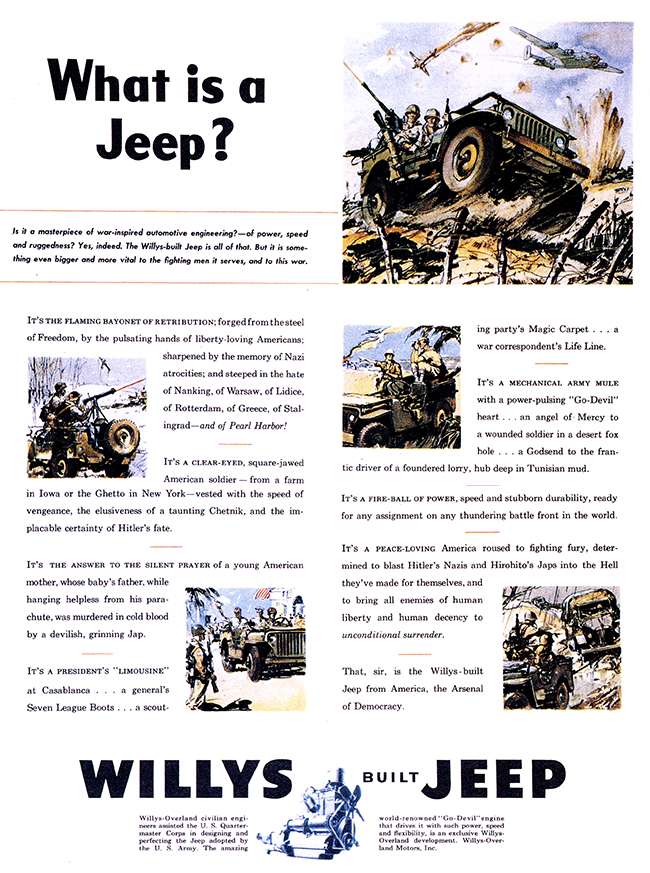
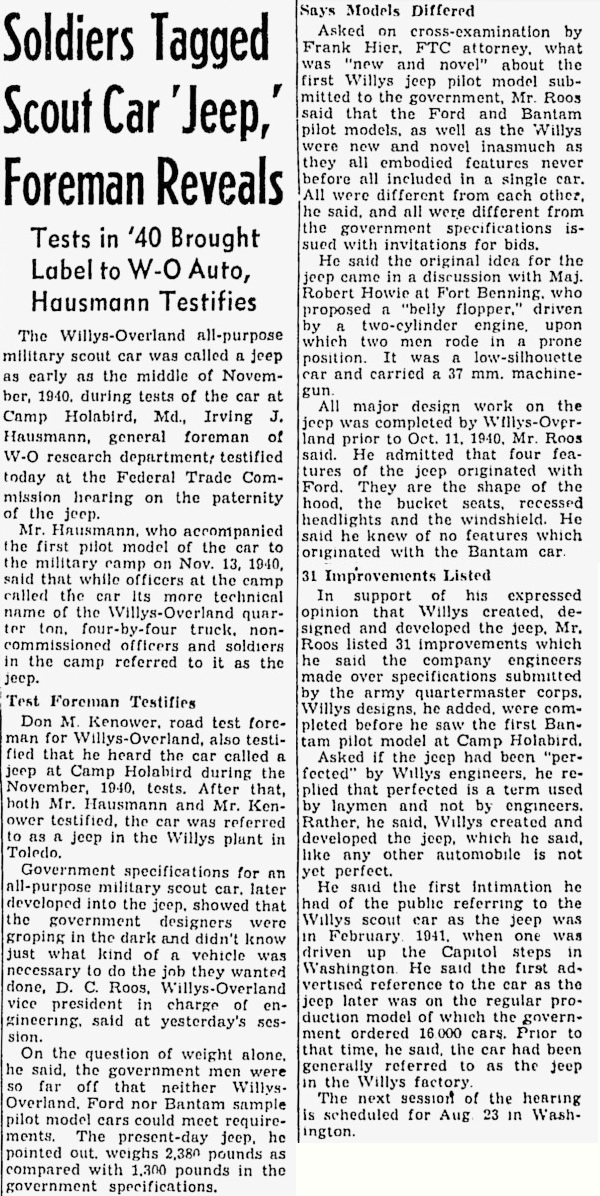




Fantastic work.
Nice to read so much Willys ‘Jeep’ research in one place.
that’s a lovely looking 1942 willys AMERICAR , too bad they didn’t include an engine , oh sure there was something under the hood , but its not an engine , it was a feeble little 4 flatty with -60 flaccid donkey-power , how very sad , no wonder everybody gutted em out and slammed in HEMIS ?
Was the Ford Lawsuit what resulted in the name Willys Overland being changed to just “Willys” on the rear bumpers of the Jeepster, Station Wagon and panel delivery vehicles in 1950? That was about the same time as the name Willys Motors, Inc. started showing up in paperwork and advertising.
Don and Chris: Glad you liked it!
Colin: I really need to do a formal schematic of the company(ies) name(s) as they shifted over the years. After all, there was the Willys manufacturing arm, Willys real estate company, and Empire Securities (and possibly others).
I’m shooting from the hip with the following info … As I understand it, technically the manufacturing arm of the company during the 1940s was the Willys-Overland Motors, Co. As I understand it, the domestic arm was shortened to the Willys Motors Company as part of the 1953 buyout. At that time, the Willys Export Company was launched to deal with international stuff.
Regarding your question, I suspect the shift to just WILLYS on the bumper was to bring the brand together as just “WILLYS” stampings rather than WILLYS in some places and WILLYS-OVERLAND in other places.
got to cut this short .. Ann’s knee went out in the grocery store .. yikes!